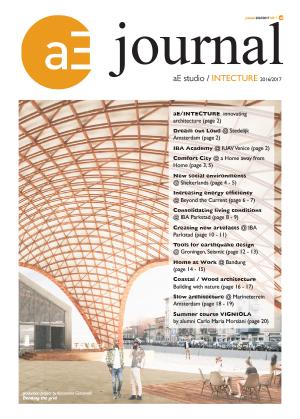Hosted by
aE Journal 2015/2016: aE/INTECTURE innovating architecture
Synopsis
The graduation studio of Architectural Engineering focuses on the integration of (new) technology in architecture. For this purpose, the name aE/ INTECTURE® was devised, which will be developed further as a brand in the coming years. Students start with a technical fascination and translate this into an architectural concept, finally being able to implement this within the environment in a responsible way. ‘If technology is the answer, what is the question?‘ Under the guidance of a team of enthusiastic (guest) lecturers, students search for the dot on the horizon that is necessary for coming up with solutions that improve the quality of the built environment and make it more sustainable. In addition, either the ‘making‘ (make) or ‘the energy and material flow’ (flow) is used and applied as a basis in different contexts.
Digital fabrication
The ‘make‘ theme has already earned aE/ INTECTURE an excellent reputation through the integration of the ideology of ‘digital fabrication’ by Pieter Stoutjesdijk. Pieter was the faculty’s best student in 2013 and now exhibits his work at the Stedelijk Museum in Amsterdam. Last year, Nadia Remmerswaal also graduated from aE/INTECTURE as student of the year. She also works on innovations using digital production techniques. Stoutjesdijk recently developed the ‘Comfort Cabin’, an innovative solution for temporarily empty buildings to make them habitable for refugees. The project has been widely cited in the press and the Chief Government Architect regularly shows it as a good example of innovation. Meanwhile, Pieter has developed the ‘Comfort City‘ in collaboration with former aE/INTECTURE student Anneloes de Koff, which received the first prize in the Central Agency for the Reception of Asylum Seekers’ (COA) design contest ‘A Home away from Home’. In addition, thanks to the digital method of production, high profile chair production projects have been rolled out to the Minor in Architectural Engineering and Junior TU Delft Architectural Engineering programme.
Collaborations
Talent development and seeking out relationships with the business community and government are the points of departure for strengthening our position in society and examining how we can integrate this into the academic domain. For example, connections have been forged with the Directorate-General for Public Works and Water Management (Rijkswaterstaat), together with whom we‘ve built and managed 12 beach houses as part of the Stuiflab project during the Oerol Festival on the island of Terschelling in 2015. aE/INTECTURE has also been involved from the start as an advisor and source of inspiration in the creation of IBA Parkstad in 2020. In addition, new ideas for addressing off-the-grid housing and infrastructure solutions in kampungs (informal villages) in Indonesia have been mapped out in the recent past. Students have visited Bandung and collaborated with the local business community and university. Last year, students were assigned to work on ‘Learning from Lowlands‘, the famous annual Lowlands festival in Biddinghuizen. They examined what could be learnt from temporary building structures. Meanwhile, an inspiring design relationship has been established with the management of the Marineterrein in Amsterdam. Students and researchers are given the opportunity to collaborate on the ‘Flexible City‘ that will be developed at this unique location in the Netherlands over the coming years. Our Seismic project deals with earthquake problems in Groningen and, in particular, the design solutions being devised for that.
Inspiration and innovation
aE/INTECTURE wants to use such examples to demonstrate that architects can integrate innovative design solutions, thus contributing to the improvement of living conditions. We follow our graduates in their practice in order to see if our approach is influencing the changing world of the contemporary architect.

